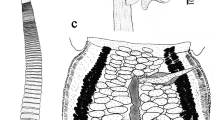Abstract
Three new species of Anthocephalum Linton, 1890 are described from dasyatid stingrays collected in the Gulf of California. Anthocephalum michaeli n. sp. is described from Dasyatis longus (Garman). This species most closely resembles A. alicae Ruhnke, 1994, but differs from this species in proglottid number. A. lukei n. sp. is also described from D. longus. This new species is most similar to A. cairae Ruhnke, 1994, but differs from that species in marginal loculi number and number of proglottids. The third new species, A. currani n. sp., is described from D. brevis (Garman). This species is most similar to A. centrurum (Southwell, 1925) Ruhnke, 1994, but differs from that species in marginal loculi number, number of testes and ovarian length. Phyllobothrium kingae Schmidt, 1978 is also consistent in morphology with species of Anthocephalum and is transferred to this genus, forming the new combination Anthocephalum kingae n. comb. This species most closely resembles A. michaeli n. sp., but differs in testicular shape. This brings the total number of species of Anthocephalum to nine. The transfer of the species Phyllobothrium arctowskii Wojciechowska, 1991, P. georgiense Wojciechowska, 1991, P. rakusai Wojciechowska, 1991 and P. siedleckii Wojciechowska, 1991 to Anthocephalum is not warranted, as these four species lack a posteriorly recurved cirrus-sac and a sinuous vagina, and have vitelline follicles uninterrupted by the ovary. Of the nine known species, all are parasitic in batoid fishes, and six are found in species of Dasyatis Garman. The phylogenetic status of Anthocephalum species in relationship to Rhinebothroides Mayes, Brooks & Thorson, 1981, Pararhineothroides Zamparo, Brooks & Barriga, 1999 and other rhinebothriin taxa is discussed.








Similar content being viewed by others
References
Agbayani, E. (2007a). Valid species of the genus Dasyatis. In R. Froese & D. Pauly (Eds.), FishBase. www.fishbase.org, version (08/2007).
Agbayani, E. (2007b). Valid species of the genus Urobatis. In R. Froese & D. Pauly (Eds.), FishBase. www.fishbase.org, version (08/2007).
Agbayani, E. (2007c). Valid species of the genus Torpedo. In R. Froese & D. Pauly (Eds.), FishBase. www.fishbase.org, version (08/2007).
Brooks, D. R., & Mayes, M. A. (1980). Cestodes in four species of euryhaline stingrays from Colombia. Proceedings of the Helminthological Society of Washington, 47, 22–29.
Caira, J. N. (1989). A revision of the North American papillose Allocreadiidae (Digenea) with independent cladistic analyses of larval and adult forms. Bulletin of the University of Nebraska State Museum, 11, 1–58.
Caira, J. N., Jensen, K., & Healy, C. J. (2001). Interrelationships among tetraphyllidean and lecanicephalidean cestodes. In D. T. J. Littlewood & R. A. Bray (Eds.), Interrelationships of the Platyhelminthes (pp. 135–158). London: Taylor and Francis.
Euzet, L. (1959). Recherches sur les cestodes tétraphyllides des sélaciens des côtes de France. Thése de PhD, Faculté des Sciences, Université de Montpellier, Montpellier, 263 pp.
Faliex, E., Tyler, G., & Euzet, L. (2000). A new species of Ditrachybothridium (Cestoda: Diphyllidea) from Galeus sp. (Selachii, Scyliorhynidae) from the south Pacific Ocean, with a revision of the diagnosis of the order, family, and genus and notes on descriptive terminology of microtriches. Journal of Parasitology, 86, 1078–1084.
Healy, C. J. (2006). A revision of selected Tetraphyllidea (Cestoda): Caulobothrium, Rhabdotobothrium, Rhinebothrium, Scalithrium, and Spongiobothrium. Doctoral Dissertation, University of Connecticut, 327 pp.
Ivanov, V. A. (2004). A new species of Rhinebothroides Mayes, Brooks & Thorson, (1981) (Cestoda: Tetraphyllidea) from the ocellate river stingray in Argentina, with amended descriptions of two other species of the genus. Systematic Parasitology, 58, 159–174.
Olson, P. D., Ruhnke, T. R., Sanney, J., & Hudson, T. (1999). Evidence for host-specific clades of tetraphyllidean tapeworms (Platyhelminthes: Eucestoda) revealed by analysis of 18S srDNA. International Journal for Parasitology, 29, 1465–1476.
Reyda, F. B. (2007). Patterns of diversity and host specificity in the cestodes of Neotropical freshwater stingrays. Doctoral Dissertation, University of Connecticut, 217 pp.
Rocka, A., & Zdzitowiecki, K. (1998). Cestodes in fishes of the Weddell Sea. Acta Parasitologica, 43, 64–70.
Ruhnke, T. R. (1994). Resurrection of Anthocephalum Linton, 1890 (Cestoda: Tetraphyllidea) and taxonomic information on five proposed members. Systematic Parasitology, 29, 159–176.
Ruhnke, T. R. (1996a). Taxonomic resolution of Phyllobothrium van Beneden (Cestoda: Tetraphyllidea) and a description of a new species from the leopard shark Triakis semifasciata. Systematic Parasitology, 33, 1–12.
Ruhnke, T. R. (1996b). Systematic resolution of Crossobothrium Linton, 1889, and taxonomic resolution of four species allocated to that genus. Journal of Parasitology, 82, 793–800.
Schmidt, G. D. (1978). Phyllobothrium kingae sp. n., a tetraphyllidean cestode from a yellow-spotted stingray in Jamaica. Proceedings of the Helminthological Society of Washington, 45, 132–134.
Wojciechowska, A. (1991). New species of the genus Phyllobothrium (Cestoda, Tetraphyllidea) from antarctic batoid fishes. Acta Parasitologica Polonica, 36, 63–68.
Zamparo, D., Brooks, D. R., & Barriga, R. (1999). Pararhinebothroides hobergi n. gen. n. sp. (Eucestoda: Tetraphyllidea) in Urobatis tumbesensis (Chondrichthyes: Myliobatioformes) form Coastal Ecuador. Journal of Parasitology, 85, 534–539.
Acknowledgements
We thank Janine N. Caira and her Gulf of California field teams for collecting specimens of A. michaeli, A. lukei, and A. currani, and Dr Caira for providing SEM micrographs of these new species. We also thank Don Duszynski for providing voucher specimens of A. kingae. This work was supported in part by NSF-BS&I grant DEB No. 9300796 and NSF-PEET No. 0118882.
Author information
Authors and Affiliations
Corresponding author
Rights and permissions
About this article
Cite this article
Ruhnke, T.R., Seaman, H.B. Three new species of Anthocephalum Linton, 1890 (Cestoda: Tetraphyllidea) from dasyatid stingrays of the Gulf of California. Syst Parasitol 72, 81–95 (2009). https://doi.org/10.1007/s11230-008-9170-6
Received:
Accepted:
Published:
Issue Date:
DOI: https://doi.org/10.1007/s11230-008-9170-6




